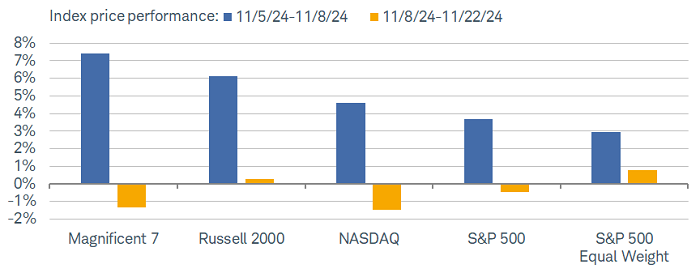Asset Management
Breadth of Life: Post-Election Market Trends

It's been an eventful few weeks. On the heels of the presidential election, stocks initially rallied with force, reflecting investor optimism over potential regulatory rollbacks and lower corporate tax rates. Shown via the blue bars in the chart below, equity indexes and the Magnificent 7 (Mag7) group of stocks were up between 3% and more than 7% in the days immediately following the election. Since then, the market's been on a choppier path, with some reversal in fortune for the Mag7 and outperformance by the equal-weighted version of the S&P 500 relative to the standard cap-weighted version.
This week is starting off with a (positive) bang, in part related to President-elect Trump's pick of Scott Bessent as Treasury Secretary. Bessent is seen as pragmatic and more constructive-leaning vs. dogmatic-leaning in terms of policy. That said, there remain ample policy uncertainties regarding tariffs, taxes, government spending and immigration; and markets could continue to swing on these.
Post-election performance breather

Source: Charles Schwab, Bloomberg, as of 11/22/2024.
The Bloomberg Magnificent 7 Index is an equal-dollar weighted equity benchmark consisting of a fixed basket of 7 widely traded companies (Alphabet, Amazon, Apple, Meta, Microsoft, NVIDIA, Tesla). Indexes are unmanaged, do not incur management fees, costs and expenses and cannot be invested in directly. Past performance is no guarantee of future results.
Sector performance has changed some gears as well. Shown below, during election week, every one of the S&P 500's 11 sectors had positive performance—led by the Consumer Discretionary and Financials sectors. In the aftermath of that week, performance has been a mixed bag, with four sectors in negative performance territory, including the crowd favorites Communication Services and Technology sectors. On the other hand, Financials (Schwab Sector Views' rating is "outperform") has continued to perform well.

Source: Charles Schwab, Bloomberg, as of 11/22/2024.
Sectors are based on the Global Industry Classification Standard (GICS®), an industry analysis framework developed by MSCI and S&P Dow Jones Indices to provide investors with consistent industry definitions. Indexes are unmanaged, do not incur management fees, costs and expenses and cannot be invested in directly. Past performance is no guarantee of future results.
The about-face by a number of sectors is in keeping with our view that sector rotations are likely to continue to be fierce. We will write more about that theme in our upcoming 2025 outlook report. In general, however, we expect that overall market breadth will remain relatively healthy, but in the context of some expected bursts of volatility.
In fact, one of the hallmarks of the bull market this year has been the exceptional breadth profile of the S&P 500. For the entirety of 2024 (thus far), the index has not yet had fewer than 60% of members trading above their 200-day moving average. At times, the share has exceeded 80%, underscoring the impressive comeback for the "average stock" and throwing cold water on the notion that only a handful of stocks (i.e., the Mag7) had been advancing. As shown below, 73% of S&P 500 members are trading above their 200-day moving average as of last week's close.
Breadth stronger for longer

Source: Charles Schwab, Bloomberg, as of 11/22/2024.
Indexes are unmanaged, do not incur management fees, costs and expenses and cannot be invested in directly. Past performance is no guarantee of future results.
What's notable about the aforementioned 60-80% range is how rare that has been over the past few years. Even for the bull market that started in March 2020, the S&P 500 went through much wider and wilder swings in terms of individual member participation. Plus, even more notable in 2021 was the deterioration in breadth as the index continued to climb to new all-time highs. We have written about this several times this year, but we continue to think that one of the bigger risks to the market's run would be a repeat of the poor breadth progression in 2021. We'll opine on that more in our 2025 outlook—coming out in a couple weeks—but should that scenario materialize, it would raise a red flag for the bull.
So far, the breadth setup is virtually the same as it was heading into the election. A firm majority of members in the S&P 500 were (and still are) in an uptrend, and that has spanned across most sectors. As shown in the chart below, only two sectors have fewer than half of their member above their 200-day moving average, and they're considered traditional defensives (Consumer Staples and Health Care).
Sectors' breadth

Source: Charles Schwab, Bloomberg, as of 11/22/2024.
S&P 500 sectors shown. Sectors are based on the Global Industry Classification Standard (GICS®), an industry analysis framework developed by MSCI and S&P Dow Jones Indices to provide investors with consistent industry definitions. Past performance is no guarantee of future results.
The lack of leadership from the defensives—and clear strength from cyclicals (like Financials and Industrials)—is perhaps the most important message the market is sending right now. Even more importantly, it is unchanged from before the election. Despite a big performance spike for sectors like Financials and Industrials in the aftermath of the election, the breadth story did not change.
That further reinforces the fact that the market treated the election more as a clearing event, as opposed to somehow changing its tune and pricing in the next four years of policy. Admittedly, the swing in the Energy sector has been notable, with 90% of members above their 50-day moving average but just 52% above their 200-day moving average (a signal of significant near-term upside momentum). However, that move hasn't been accompanied by a material increase in oil prices—a divergence that has historically been negative in the near term for Energy stocks.
We continue to think the best thing stocks have going for them is their own momentum. In fact, the S&P 500 Momentum Index is having its best year since 1999. That year alone is a reminder that momentum doesn't carry on forever, and that it often breeds frothy investor sentiment.
Speaking of some froth in investor sentiment, the chart below shows flows in and out of equity exchange-traded funds (ETFs). Flows have been trending higher during the current bull market, but the latest surge has taken flows to above the +- 2 standard deviations range in place over the past couple of years. When that last occurred earlier this year, as shown, there was some short-term give-back in flows.
Surging equity ETF flows

Source: Charles Schwab, Strategas, as of 11/22/2024. ETF = exchange-traded fund
We often remind investors that stretched investor sentiment is often a contrarian indicator for the market, but it does not represent anything resembling a short-term market timing tool. What it does suggest is that if a negative catalyst were to present itself to the market, the downside could kick in more quickly than under more benign sentiment conditions.
In sum
With a strong breadth setup for now, it's hard to fish out a negative message from the market other than frothy sentiment. We'll continue to keep an eye on any underlying deterioration in participation if the indexes continue to make new highs. As noted, there has been some churn in performance since the initial post-election rally courtesy of the unique uncertainty with regard to government policy. We live in a world where the "tails" of probabilities (events that occur at the tail ends of a normal distribution curve) need to be assessed. The tails in the current environment are arguably "fatter" than what might normally be the case, meaning there could be outsized downside and/or upside risks associated with policy-related decisions. More to come on that front in our upcoming 2025 outlook report.

